
The Norton Motorcycle Company is a brand of motorcycles headquartered in Solihull, West Midlands,, England. For some years around 1990, the rights to use the name on motorcycles were owned by North American financiers.

Velocette is a range of motorcycles made by Veloce Ltd, in Hall Green, Birmingham, England. One of several motorcycle manufacturers in Birmingham, Velocette was a small, family-owned firm, selling almost as many hand-built motorcycles during its lifetime as the mass-produced machines of the giant BSA and Norton concerns. Renowned for the quality of its products, the company was "always in the picture" in international motorcycle racing from the mid-1920s until the 1950s, culminating in two World Championship titles and its legendary and still-unbeaten 24 hours at over 100 mph (161 km/h) record. Veloce, while small, was a great technical innovator and many of its patented designs are commonplace on motorcycles today, including the positive-stop foot shift and swinging arm rear suspension with hydraulic dampers. The business suffered a gradual commercial decline during the late 1960s, eventually closing in February 1971.

A. J. Stevens & Co. Ltd was a British automobile and motorcycle manufacturer in operation from 1909 to 1931. The company was founded by Joe Stevens in Wolverhampton, England. After the firm was sold, the name continued to be used by Matchless, Associated Motorcycles and Norton-Villiers on four-stroke motorcycles until 1969, and since the name's resale in 1974, on lightweight, two-stroke scramblers and today on small-capacity roadsters and cruisers. The company held 117 motorcycle world records.
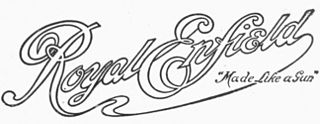
Royal Enfield was a brand name under which The Enfield Cycle Company Limited of Redditch, Worcestershire, England, sold motorcycles, bicycles, lawnmowers and stationary engines which it manufactured. Enfield Cycle Company also used the brand name "Enfield" without the "Royal".
The Scott Motorcycle Company was owned by Scott Motors (Saltaire) Limited, Saltaire, West Yorkshire, England and was a well-known producer of motorcycles and light engines for industry. Founded by Alfred Angas Scott in 1908 as the Scott Engineering Company in Bradford, Yorkshire, Scott motorcycles were produced until 1978.
Initially started in a rented workshop, Alfred moved the business to Hirstwood Works, Hirstwood Road, Saltaire. This building is still standing and has industrial use.

Excelsior, based in Coventry, was a British bicycle, motorcycle and car maker. They were Britain’s first motorcycle manufacturer, starting production of their own ‘motor-bicycle’ in 1896. Initially they had premises at Lower Ford Street, Coventry, and 287-295 Stoney Stanton Road, Hillfields, Coventry, Warwickshire before moving to Kings Road, Tyseley, Birmingham in 1921.

Matchless is one of the oldest marques of British motorcycles, manufactured in Plumstead, London, between 1899 and 1966. A wide range of models were produced under the Matchless name, ranging from small two-strokes to 750 cc four-stroke twins. Matchless had a long history of racing success; a Matchless ridden by Charlie Collier won the first single-cylinder race in the first Isle of Man TT in 1907.

Douglas was a British motorcycle manufacturer from 1907 to 1957 based in Kingswood, Bristol, owned by the Douglas family, and especially known for its horizontally opposed twin cylinder engined bikes and as manufacturers of speedway machines. The company also built a range of cars between 1913 and 1922.
OK-Supreme was a British motorcycle manufacturer from 1899 to 1939 located in Birmingham. Grass-track racing versions of the machines continued to be available until 1946.

The Dot Cycle and Motor Manufacturing Company was established by Harry Reed in Salford, Lancashire, a city near Manchester, England, in 1903. By 1906 they had built their first motorcycle, using a Peugeot engine.

New Imperial was a British motorcycle manufacturer founded by Norman Downes in Birmingham, between 1887 and 1901, and became New Imperial Motors Ltd in 1912, when serious production commenced. New Imperial made innovative motorcycles that employed unit construction and sprung heel frames long before they became commonplace, and were moderately successful in competition. The 1920s were a financially successful decade, enabling the innovations of the 1930s that fought decline.
Blackburne was a trade name of Burney and Blackburne Limited a British manufacturer of motorcycles from 1913 to 1922 at Tongham near Farnham, Surrey. They were also a major supplier of engines to other motor cycle and light car makers and continued to make these until 1937. Burney and Blackburne also made small aircraft engines.
Greeves Motorcycles was a British motorcycle manufacturer founded by Bert Greeves which produced a range of road machines, and later competition mounts for observed trials, scrambles and road racing. The original company produced motorcycles from 1952, funded by a contract with the Ministry of Pensions for their Invacar, a three-wheeler for disabled drivers.
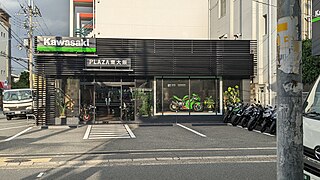
Kawasaki Motors, Ltd. is a Japanese mobility manufacturer that produces motorcycles, all-terrain vehicles, utility vehicles, watercraft, outboard motors, and other electric products. It derives its origins from Kawasaki Aircraft Industries, a subsidiary of Kawasaki Heavy Industries, and is rooted in the motorcycle, boat, and engine businesses. In 1953, they began manufacturing engines for motorcycles and have since produced products such as the Mach and Ninja series in motorcycles and the Jet Ski, which has become a generic term for personal watercraft. Until 2021, it was a division of Kawasaki Heavy Industries, known as the Kawasaki Aerospace Company (川策重工業汎用機カンパニー) and later the Kawasaki Motorcycle & Engine Company (川崎重工業モーターサイクル&エンジンカンパニー). In 2021, it was separated as Kawasaki Motors, Ltd, a wholly owned subsidiary of Kawasaki Heavy Industries.
Alfred Angas Scott (1875–1923) was a British motorcycle designer, inventor and founder of the Scott Motorcycle Company. A prolific inventor, he took out over 50 patents between 1897 and 1920, mostly concerning two-stroke engines and road vehicles. Scott was a keen potholer and the second president of the Gritstone club. In July 1923 Scott travelled back to Bradford in his open Scott Sociable wearing wet potholing clothes and contracted pneumonia from which he died.

The Manxman was a motorcycle designed and built by H. J. Hatch and Eric Walker of the Excelsior Motor Company in Tyseley, Birmingham. Although it never won the Isle of Man TT, the Manxman was a very popular and reliable motorcycle which was successful in international racing and the Manx Grand Prix. Production was halted by World War II and did not resume.
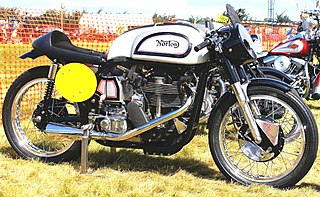
The Norton Manx or Manx Norton is a British racing motorcycle that was made from 1947 to 1962 by Norton Motors Ltd. Norton had contested every Isle of Man TT race from the inaugural 1907 event through into the 1970s, a feat unrivalled by any other manufacturer, and the development and honing of the Manx racing motorcycle was another step in this racing achievement.
Silk Engineering was a British motorcycle manufacturer established by George Silk and Maurice Patey and based at Darley Abbey, Derbyshire. They produced Silk 700S two-stroke motorcycles until 1979. Problems with spare parts and rising costs led to the company ceasing manufacture.
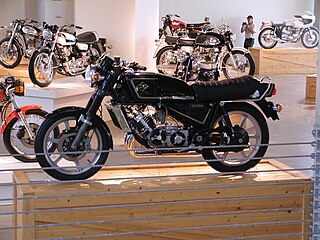
The Silk 700S was a British motorcycle made by Silk Engineering between 1975 and 1979 in Darley Abbey, Derbyshire, UK.
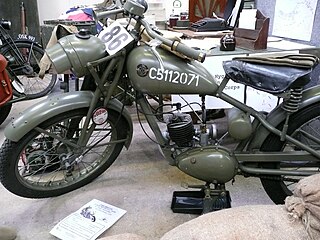
The Royal Enfield WD/RE known as the "Flying Flea" was a lightweight British motorcycle developed by Royal Enfield for the British War Office as a means of transport that could be dropped by parachute or carried in gliders, to quickly carry messages and signals between airborne and assault troops where radio communications were not in place.
















